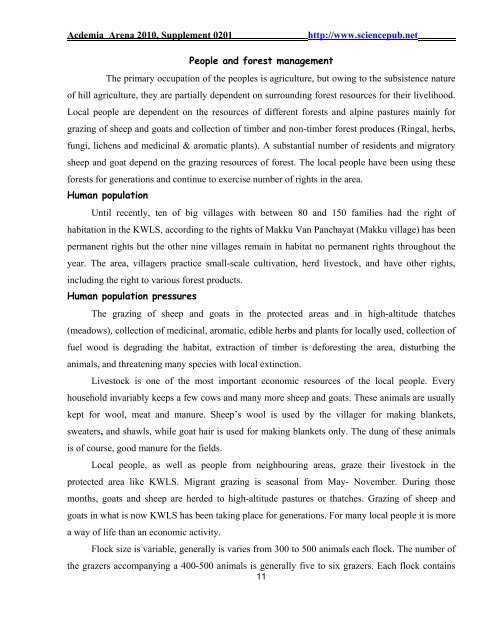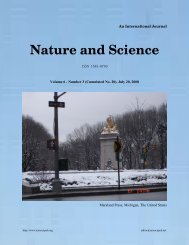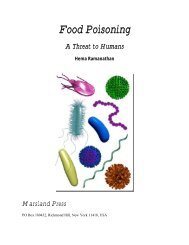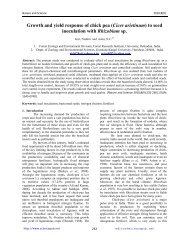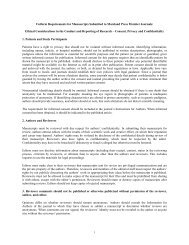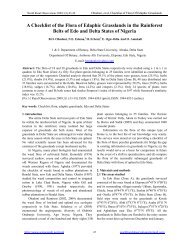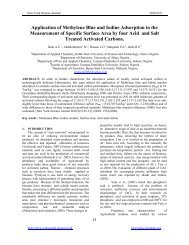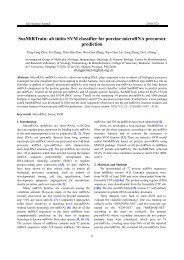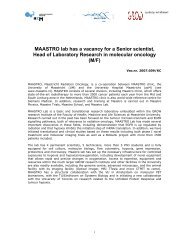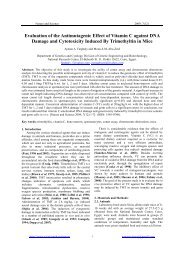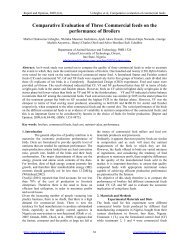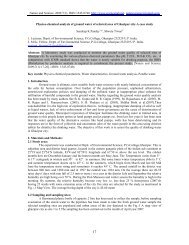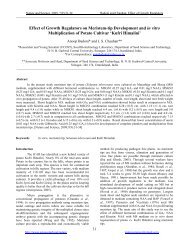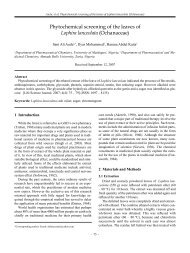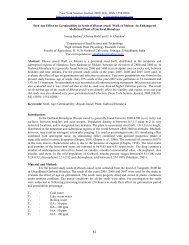Ecological, Social and Commercial Role of Lichens in India with ...
Ecological, Social and Commercial Role of Lichens in India with ...
Ecological, Social and Commercial Role of Lichens in India with ...
You also want an ePaper? Increase the reach of your titles
YUMPU automatically turns print PDFs into web optimized ePapers that Google loves.
Acdemia Arena 2010, Supplement 0201<br />
http://www.sciencepub.net<br />
People <strong>and</strong> forest management<br />
The primary occupation <strong>of</strong> the peoples is agriculture, but ow<strong>in</strong>g to the subsistence nature<br />
<strong>of</strong> hill agriculture, they are partially dependent on surround<strong>in</strong>g forest resources for their livelihood.<br />
Local people are dependent on the resources <strong>of</strong> different forests <strong>and</strong> alp<strong>in</strong>e pastures ma<strong>in</strong>ly for<br />
graz<strong>in</strong>g <strong>of</strong> sheep <strong>and</strong> goats <strong>and</strong> collection <strong>of</strong> timber <strong>and</strong> non-timber forest produces (R<strong>in</strong>gal, herbs,<br />
fungi, lichens <strong>and</strong> medic<strong>in</strong>al & aromatic plants). A substantial number <strong>of</strong> residents <strong>and</strong> migratory<br />
sheep <strong>and</strong> goat depend on the graz<strong>in</strong>g resources <strong>of</strong> forest. The local people have been us<strong>in</strong>g these<br />
forests for generations <strong>and</strong> cont<strong>in</strong>ue to exercise number <strong>of</strong> rights <strong>in</strong> the area.<br />
Human population<br />
Until recently, ten <strong>of</strong> big villages <strong>with</strong> between 80 <strong>and</strong> 150 families had the right <strong>of</strong><br />
habitation <strong>in</strong> the KWLS, accord<strong>in</strong>g to the rights <strong>of</strong> Makku Van Panchayat (Makku village) has been<br />
permanent rights but the other n<strong>in</strong>e villages rema<strong>in</strong> <strong>in</strong> habitat no permanent rights throughout the<br />
year. The area, villagers practice small-scale cultivation, herd livestock, <strong>and</strong> have other rights,<br />
<strong>in</strong>clud<strong>in</strong>g the right to various forest products.<br />
Human population pressures<br />
The graz<strong>in</strong>g <strong>of</strong> sheep <strong>and</strong> goats <strong>in</strong> the protected areas <strong>and</strong> <strong>in</strong> high-altitude thatches<br />
(meadows), collection <strong>of</strong> medic<strong>in</strong>al, aromatic, edible herbs <strong>and</strong> plants for locally used, collection <strong>of</strong><br />
fuel wood is degrad<strong>in</strong>g the habitat, extraction <strong>of</strong> timber is deforest<strong>in</strong>g the area, disturb<strong>in</strong>g the<br />
animals, <strong>and</strong> threaten<strong>in</strong>g many species <strong>with</strong> local ext<strong>in</strong>ction.<br />
Livestock is one <strong>of</strong> the most important economic resources <strong>of</strong> the local people. Every<br />
household <strong>in</strong>variably keeps a few cows <strong>and</strong> many more sheep <strong>and</strong> goats. These animals are usually<br />
kept for wool, meat <strong>and</strong> manure. Sheep’s wool is used by the villager for mak<strong>in</strong>g blankets,<br />
sweaters, <strong>and</strong> shawls, while goat hair is used for mak<strong>in</strong>g blankets only. The dung <strong>of</strong> these animals<br />
is <strong>of</strong> course, good manure for the fields.<br />
Local people, as well as people from neighbour<strong>in</strong>g areas, graze their livestock <strong>in</strong> the<br />
protected area like KWLS. Migrant graz<strong>in</strong>g is seasonal from May- November. Dur<strong>in</strong>g those<br />
months, goats <strong>and</strong> sheep are herded to high-altitude pastures or thatches. Graz<strong>in</strong>g <strong>of</strong> sheep <strong>and</strong><br />
goats <strong>in</strong> what is now KWLS has been tak<strong>in</strong>g place for generations. For many local people it is more<br />
a way <strong>of</strong> life than an economic activity.<br />
Flock size is variable, generally is varies from 300 to 500 animals each flock. The number <strong>of</strong><br />
the grazers accompany<strong>in</strong>g a 400-500 animals is generally five to six grazers. Each flock conta<strong>in</strong>s<br />
11


